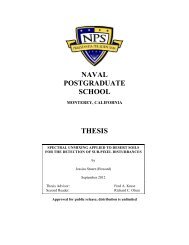October 2000 Newsletter - Naval Postgraduate School
October 2000 Newsletter - Naval Postgraduate School
October 2000 Newsletter - Naval Postgraduate School
Create successful ePaper yourself
Turn your PDF publications into a flip-book with our unique Google optimized e-Paper software.
RESEARCH AND EDUCATION<br />
WEAPONEERING: FROM A JTCG/ME PERSPECTIVE, continued from page 10<br />
In May 1999, the Office of the Secretary of Defense<br />
(OSD) revised DoD Directive 5000.2R to require the<br />
procuring agency to provide weapon effectiveness data<br />
for use in JMEMs for weapons in the acquisition process<br />
prior to their achieving initial operational capability.<br />
OSD also required that these data be prepared using<br />
methodology coordinated with the JTCG/ME.<br />
The resources to operate the program are distributed<br />
to the JTCG/ME directly from the Director of Operational<br />
Test and Evaluation, Office of the Secretary of<br />
Defense. Chartered by the Joint Logistics Commanders<br />
with two-star or civilian-equivalent Offices of Primary<br />
Responsibility (OPR), the JTCG/ME is guided by a<br />
steering committee composed of members from each of<br />
the services, the Joint Chiefs of Staff (J-8), the Defense<br />
Intelligence Agency, and the Defense Threat Reduction<br />
Agency. The Army continues as DoD Executive Agent,<br />
as it had been with the original ad hoc group, and the Director<br />
of the U.S. Army Materiel Systems Analysis Activity at the<br />
Aberdeen Proving Ground, Maryland, presides. The committee<br />
is composed of civilian and military weapon/munitions<br />
experts throughout the defense department to ensure objective,<br />
scientific guidance in the development and employment<br />
of non-nuclear munitions. An organizational chart is shown<br />
in Figure 1.<br />
NPS Involvement With the JTCG/ME<br />
About six years ago, Professor Morris Driels of the Depart-<br />
Figure 2. Target Acquisition Program in JAWS.<br />
Figure 1. Organization of the JTCG/ME.<br />
ment of Mechanical Engineering was interested in pursuing a<br />
new direction in his research activities, branching away from<br />
the more traditional Mechanical Engineering subject matter<br />
he had been working with at several universities for over<br />
twenty five years. He had learned of the JTCG through a<br />
colleague in the Operations Research Department at NPS,<br />
and they began work on a project that predicted the probability<br />
that ground targets could be detected, recognized and<br />
identified from the air. By this time, the Air-to-Surface<br />
Working Group -ASWG (Figure 1) based at Eglin AFB was<br />
consolidating its products into a CD-ROM and away from<br />
the traditional orange covered paper JMEMs that users<br />
were familiar with since the inception of the group. This<br />
product, known as the Joint Air-to-Surface<br />
Weaponeering System, or JAWS, is the focal point of all<br />
Air-to-Surface (AS) activities, and although not a strict<br />
part of weaponeering, the Target Acquisition program<br />
developed at NPS was incorporated into it in 1998. A<br />
sample screen is shown in Figure 2, and indicates the<br />
probability a target may be detected as a function of<br />
altitude, terrain masking, target size and contrast, and<br />
other factors.<br />
Following this work, Professor Driels became involved<br />
in the analysis of the delivery accuracy of weapons,<br />
particularly that of the AGM-65 Maverick missile and<br />
the GBU 31/32 JDAM guided bomb. He was also<br />
vaguely aware of the other components of weaponeering<br />
that others were working on, and needed to be done<br />
--continued on page 12<br />
NPS Research page 11<br />
<strong>October</strong> <strong>2000</strong>
















